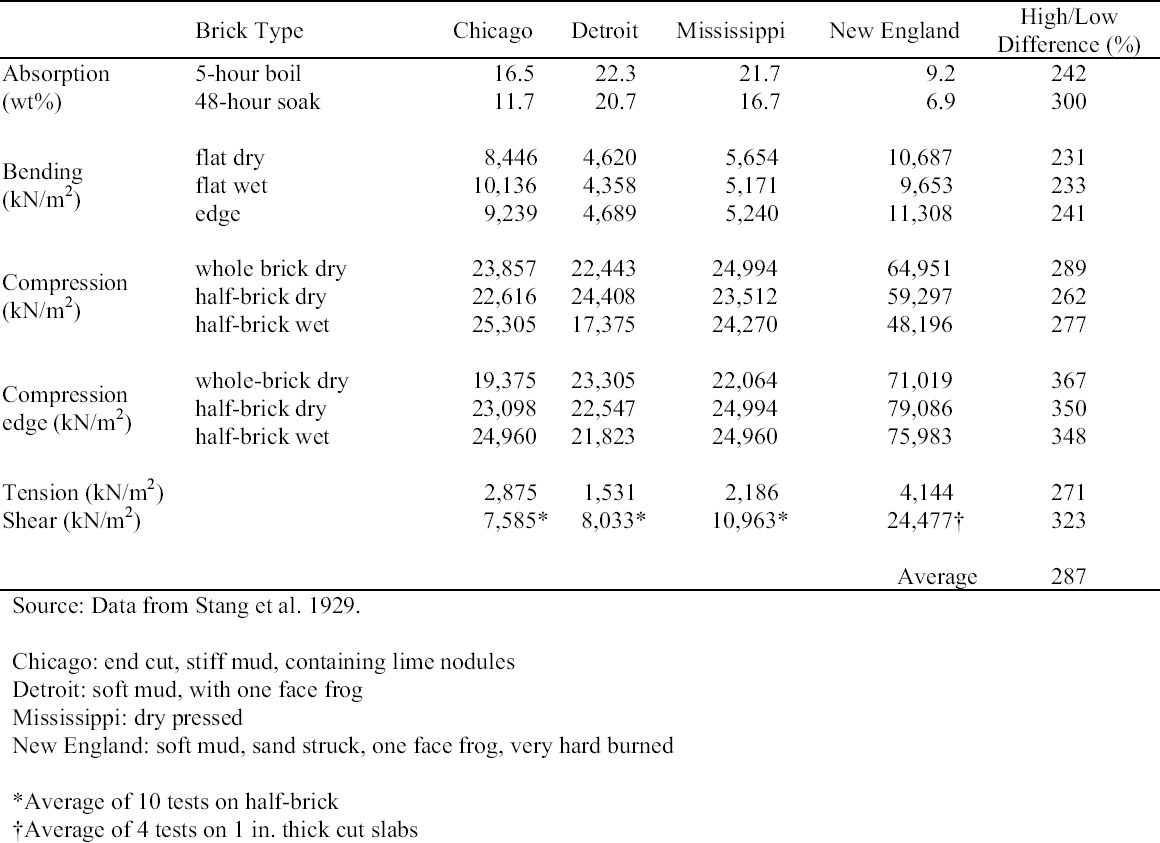ENGINEERING PROPERTIES OF HISTORIC BRICK: VARIABILITY CONSIDERATIONS AS A FUNCTION OF STATIONARY VERSUS NONSTATIONARY KILN TYPESDEBRA F. LAEFER, JUSTIN BOGGS, & NICOLE COOPER
2 ENGINEERING PROPERTIESAn evaluation of masonry studies from the early 20th century and more recent research related to replicated historic brick indicate that kiln selection is a major cause of historic brick's inconsistent engineering properties. Tests of early 20th-century brick clearly document substantial variability in compression, tension, and absorption. Brick data from four parts of the United States (Chicago, Detroit, Mississippi, and New England), from as recently as 1929, display a large amount of scatter across a wide variety of engineering properties (table 1). Compressive strengths ranged from 19,375 kN/m2 to 71,019 kN/m2, tensile strengths from 1,531 kN/m2 to 4,144 kN/m2, bending strengths from 4,358 kN/m2 to 10,136 kN/m2, and shear strengths from 7,585 kN/m2 to 24,477 kN/m2 (Stang et al. 1929). In a separate 1929 study, McBurney's testing of more than 500 brick representing 27 manufacturers demonstrated that specimen behavior is influenced
The high level of performance variability of historic material stands in strong contrast to modern expectations and experience. Modern standards cate-gorize brick into one of three weathering grades (severe, moderate, or negligible). For each, minimum performance standards are set for strength (table 3) (ASTM 2004). According to this standard, five randomly selected brick must exhibit a minimum compressive strength of 20,685, 17,238, and 10,343 kN/m2 for the severe, moderate, and negligible grades, respectively (ASTM 2004). There are similar, slightly less rigorous standards for any individual brick, which include absorption and saturation limits (table 3). ASTM C62 also limits dimensional variations by specifying the maximum amount of variation from the standard dimensions (e.g., 5 mm in any direction for a 76–102 mm wide brick) (ASTM 2004). Extensive testing by Subasic and Borchelt (1993) on modern materials show performance capabilities far in excess of these minimum requirements, with an average compressive strength of 12,040 kN/m2 and an average 24 hour cold absorption of 5.4% (weight/weight). Modern performance prediction of historic material is difficult because of the wide range of performance possibilities and the poor correlation between various performance indicators. Among 13 engineering properties tested by Stang and associates (1929), there was an average 287% difference between the low and high results (based upon 4 to 10 specimens per brick type), with poor correlation, if any, between brick types (see table 1). Work by McBurney (1929) on more than 40 designations of brick demonstrated no relationship between compressive strength and modulus of rupture or among testing orientations (i.e., flat, edge, and end) (see table 2); because of modern manufacturing standardization for present-day brick, such variability would no longer be in evidence. Given the potential for nearly an order of magnitude difference in various engineering properties across various historic brick, identification of proper prototype values for historic materials remains a major challenge (Laefer 2001). Value selection for compressive brick strength is of particular importance, as it is a required input variable for determining overall masonry strength (MSJC 2002). Since unit compressive strength is known to have an inverse relationship with absorption (table 4) and a direct correlation with firing temperature, an investigation into the application of heat in various firing methods and equipment will help form realistic expectations regarding the anticipated range of performance values. |
